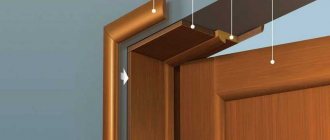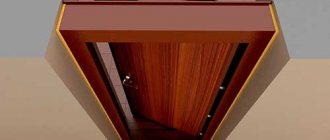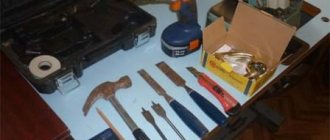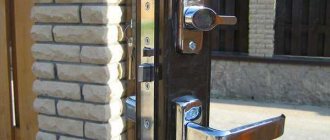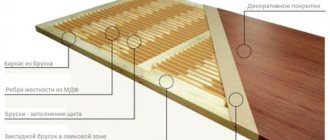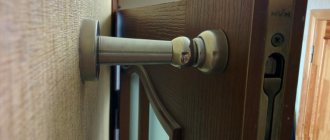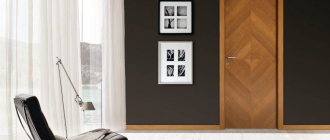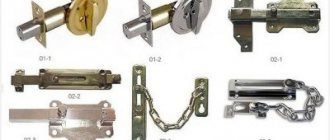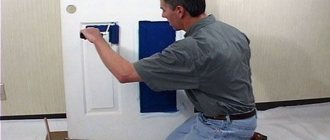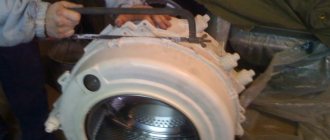The most convenient and reliable modern locking device is a magnetic lock. It is widely used for doors of apartment buildings, workshops and other office premises. This lock allows you to restrict access to certain persons, which is a necessity in many industrial enterprises. The magnetic lock is also wear-resistant and has a long service life. Despite this, failure of even such a durable locking mechanism becomes inevitable over time. In this case, it will be much more profitable not to buy a new lock, but to repair it. The company in Moscow offers repairs of magnetic locks of any complexity at an affordable price.
Tips and tricks
If you need to replace any small parts in the door handle mechanism, then you should be as careful and attentive as possible. Carrying out such work can be hazardous
And it’s not difficult to lose small elements, so you need to act carefully
When choosing a suitable door handle, do not forget about its design. This element should suit the surrounding environment in both color and style. Fortunately, today there are a great variety of different options for metal doors in stores. Your task is to choose the optimal one.
When choosing a new handle, you need to remember that such products can be right-handed or left-handed. If you buy an option that is not the most convenient for you, then you will not be able to correct your mistake. You will have to change the product or buy another one.
Door handles are often replaced because noticeable and unsightly abrasions appear on their surface. They negatively affect the appearance of the fittings. Of course, it all depends on the wishes of the home owners. However, if we are talking about a public institution, a large office or a company, then it is better to install new handles so as not to spoil the impression of the company.
How to repair the handle on the front door, watch the video.
Types of pens
There are three main types of door handles:
- Round rotary. They are an integral part of the mortise lock, which is activated by turning the handle clockwise or counterclockwise.
- Push. The difference from the first point is the presence of a convenient lever handle, which opens the lock when pressed and closes it when returning to its original position. This option is the most convenient for both interior and entrance doors.
- Stationary (usually shaped like a ball or bracket). These handles are not connected to the lock; they perform a decorative function and serve as a handle when opening the door leaf. Repairing this type of door handle involves either tightening loose bolts or replacing it with a new product.
Round rotary handle secured with locking mechanism
What could be the reasons for the problem?
There are no perfect locks, but before they break, they always “signal” that there are problems.
Signs of imminent failure of the locking mechanism:
- jams when opening and closing;
- when turning, the key gets stuck;
- does not always close;
- key slipping;
- suspicious clicks.
There are many reasons why the door lock does not close:
- ingress of various objects into the structure;
- incorrect manipulations when trying to open and close;
- metal shavings, dust, plastic fragments got inside the rubbing parts of the mechanism (cylindrical locks are susceptible to breakage);
- Regular preventive maintenance is not carried out - lubrication, washing with special means;
- increased humidity, which causes deformation of the wooden door leaf;
- constant closing of the sash with great physical force (slamming);
- the key is not used for its intended purpose - opening bottles, etc.;
- skewed door leaf;
- replacing the original key with a low-quality duplicate;
- manufacturing defects.
The reason for the lock jamming is also incorrect installation performed by a person without the proper skills:
- insufficient number of hinges, which caused the door leaf to sag;
- loop mechanisms are installed incorrectly, unevenly;
- independent replacement of a high-quality rubber seal with a self-adhesive one;
- if there is no gap between the frame/sash, the hinges will put pressure on the canvas.
Breaking into a jammed locking mechanism is only a last resort. After a break-in, you should go to the store, buy a new one, and install it so that the entrance does not remain open for a long time. Mortise models must be replaced with new ones. For example, electromagnetic locks of the new generation - they come in mortise and padlock types. More information on protective mechanisms can be found on the forum.
Lock jamming is a serious problem, the solution to which must be sought in the keyhole. The protective mechanism can break if operating conditions are not met, prevention is not carried out, and also due to physical impact. To open the lock, you should use the tips described above.
Causes of problems
There are different ways to open the front door when the lock or the door itself is blocked. This depends on the complexity of the locking mechanism, the reason for the blocking and the nature of the door: knocking down an iron door at the entrance to a home is much more difficult than an ordinary wooden one.
Breakdowns are possible in both expensive and cheap devices. The most common include the following:
- mechanical damage - for example, breakage and jamming of a key, jamming of moving parts in the absence of lubrication, etc. Some of them can be eliminated yourself and still open the front door. Repairing others will require the participation of specialists;
- manufacturing defects - it is necessary to call not just specialists, but representatives of the company that produces locking devices;
- incorrect operating mode - lack of cleaning, lubrication, sudden slamming, lead to partial wear of some elements of the mechanism, which causes the key to jam. As a rule, such problems can be resolved on their own;
- sagging or misalignment of the sash is a problem that can only be solved by specialists. It is unrealistic to reinstall an iron entrance door with your own hands;
Door distortion
Incorrect installation of the block - again, cannot be corrected independently.
It is worth noting that if a really complex lock that requires several degrees of protection is jammed on the front door, you will not be able to open the door yourself even if you want to. In order not to aggravate the situation, it is necessary to call the company’s specialists.
Call the master
How to adjust the leaf if it does not fully fit into the door frame
In some cases, the leaf can be adjusted if immediately after installation, or during operation, it no longer fits into the door frame. In such cases, you should resort to the following algorithm:
- First of all, it is necessary to determine the location where the defect occurred and which particular element of the fittings needs to be adjusted.
Broken interior door handle
- If the blade needs to be lifted from its current position, spacer washers threaded onto the hinge mechanism rod will help.
- If problems arise with the lock, you need to replace the spring in the core or tongue.
Disassembling the lock
- If the door is skewed, check the straightness of the landing rod.
- The best solution would be to purchase complex hangers that can be adjusted in several directions with a simple screwdriver, which will always keep the door leaf structure in the desired position.
Adjustable hinges
Subject to the requirements and recommendations of experts, as well as when choosing a door leaf whose technical characteristics meet the operating conditions, an interior door can serve for decades and not require repair or replacement.
Replacing an interior door
How to replace the cylinder in a lock
The procedure does not require a special tool; the mechanism can be changed independently without special skills or practical experience. Replacing the cylinder mechanism consists of three stages.
Stage No. 1. Dismantling the larva
1. Open the door leaf.2. Remove decorative trims from both sides of the canvas.3. Remove the long screw in the middle of the end plate that holds the cylinder in place. After this, the larva is held in the mounting hole only by the rotary cam.4. Uncheck the box. To do this, you need to insert the key into the keyhole and turn it clockwise about 10-15°. 5. The rotary cam will go inside the locking mechanism body and allow the core to be removed.6. Pull the key and remove the cylinder. The larva can be pulled toward the room or pushed out; it comes out equally easily in both directions. If difficulties arise when dismantling the core, it means that the mechanism has not been completely disassembled; all steps must be checked again.
Before you buy a new cylinder, you should carefully inspect the old locking mechanism. If no defects or worn parts are visually visible, you can try to lubricate and clean the cylinder. Perhaps this will help restore the lock's functionality and replacement of the core will not be necessary
If cleaning and lubrication do not help, the cylinder must be measured in order to buy an identical mechanism for a replacement. Important characteristics are the overall length of the cylinder, the diameter and the location of the rotary cam. Depending on the design of the core, the flag may be located in the middle of the structure or shifted to one of the ends.
Stage No. 2. Buying a new core
It is not enough to know how to change the lock cylinder, you also need to choose it correctly. This stage is extremely important, since the quality of the new cylinder determines the reliability and burglary resistance of the lock, its service life and the ease of use of the locking system as a whole. It should be remembered that the main parameter when choosing a larva is quality. It is better to purchase a locking mechanism from a well-known brand than to try to save money and buy a cheap product.
Trusted manufacturers use high-quality and durable materials to manufacture the cores of cylinder locks, while the cost of the design is most often due to the use of parts made of fragile silumin or short-lived plastic. Such mechanisms are poorly protected from forceful hacking, quickly wear out and fail.
Nuances to consider when choosing:
- the mounting hole on the old and new core must match. The distance from the end of the larva to this hole in extreme cases may be slightly greater;
— the diameter of the cylinder should not exceed the same size of the old mechanism. Otherwise, the cylinder will not fit into the mounting hole;
— the length of the mechanism must exactly match the thickness of the door leaf. A larva that is too long or short will protrude beyond the canvas or sink heavily into it. This will make it impossible to install a decorative armor plate on the keyhole. It is allowed to exceed the length of the cylinder by no more than 10 mm; Different manufacturers complete the locking device with different numbers of keys. It is worth choosing a mechanism with a sufficient number of keys so that you do not have to make duplicates later;
— you need to decide on the design of the locking mechanism: the cylinder can have keyholes at both ends or on the room side end with a turntable that opens the lock from the inside without a key;
— there is a very large selection of key shapes: from ordinary “English” to perforated or laser. As a rule, the more complex the key, the higher the secrecy of the locking mechanism and its resistance to burglary;
— it is worth considering the color of the larva so that the core does not stand out against the background of the castle.
Stage No. 3. Cylinder installation
Before replacing the cylinder in the lock, it is worth checking its dimensions again and comparing it with the old locking mechanism. During installation, the same steps are performed as during disassembly, carried out in reverse order:
- Before assembly, you must turn the key in the hole to remove the tongue.
- After installing the cylinder mechanism, you need to use a screw from the end of the door to get into the fastening hole of the core. To do this, the larva is moved back and forth until the screw is engaged. After the hardware is completely twisted, the cylinder should stop moving.
- Before installing decorative trims, it is worth checking the operation of the lock. The key should fit smoothly into the keyhole and turn easily, and the bolts should come out freely. When the locking mechanism is activated, there should be no extraneous sounds. You need to check the unlocking and locking from inside and outside the room.
- Decorative elements are mounted in the inspection field.
Tools and materials
To install the mechanism you will need the following materials:
- handles of any shape (round, in the shape of the letter “G”) – 2 pieces;
- cylinder mechanism with spring;
- fastening screws that connect the cylinder mechanisms;
- crossbars;
- sockets for closing cylinder devices – 2 pieces.
In addition to materials, the work requires a small set of tools:
- a simple pencil;
- roulette;
- drill;
- office knife;
- chisels at 0.1 and 0.2 cm;
- feather drill 2.3 cm;
- drill 0.2 cm;
- crown 5.4 or 5 cm based on the thickness of the door;
- masking tape;
- hammer.
If you don’t have any of the listed tools at home, you will have to buy more. Their cost is low, and they are always useful on the farm.
Options for breakdowns and repairs
As a rule, people encounter the following malfunctions of handles:
- Sticks;
- Not returned;
- The handle falls out of the socket;
- It turns.
The mechanism jams
Jamming is a breakdown that usually has nothing to do with the handle. The reason usually lies in the lock or in an incorrectly configured door. To pinpoint the cause, open the door and press the handle.
You can use WD 40 to lubricate the lock elements.
If jamming does not occur when the door is open, it means that the latch is stuck in the strike plate.
To fix the problem you need to do the following:
Illustrations Description of actions
Tighten loose elements
We tighten the fastenings: Tighten the screws that secure the strike plate to the door frame; Tighten the screws that secure the lock itself to the door leaf.
Place of application of lubricant on the bar
Lubricate the rubbing parts: Lubricate the area of the strike plate that comes into contact with the latch with machine oil; Lubricate the lock latch.
Adjust the door hinges
Door Adjustment: If the cause of the sticking is that the door is not seating tightly, inspect the perimeter of the door
Pay special attention to the seal. If necessary, replace it with a new one; If the door has adjustable hinges, its position should be adjusted.
If it turns out that the handle sticks even with the door open, i.e. The problem is not the alignment of the latch with the strike plate; most likely, the lock mechanism itself is faulty.
In this case, the troubleshooting instructions are as follows:
Illustrations Description of actions
Lock lubrication process
Lubricating the latch: Lubricate the latch without disassembling the lock with machine oil or WD-40; Check the functionality of the mechanism
If this action does not bring results, follow further recommendations.
Disassembling the handle
Removing the handle: Unscrew the decorative ring-plate; Unscrew the screws that hold the socket in place; Loosen the locking screw located on the back of the handle that secures the rod;
Opening access to the mechanism
Lubricating the handle: Remove the plastic cover located inside the socket, if present; Lubricate the turning mechanism, especially paying attention to the spring and the space between the handle and the socket; Check the functionality of the mechanism. In the same way, you need to lubricate the response handle, since this may be the cause of the malfunction.
Lubricate all moving parts
Lubricating the lock: Remove the lock; Unscrew the lock cover (side); Lubricate the latch mechanism. After performing all these steps, the problem will definitely be fixed
After completing all these steps, the problem will definitely be fixed.
The lever does not return after pressing
If the handle stops springing, then there can be only one reason - the return element does not work.
In this case, you need to dismantle the handle according to the described scheme, and then perform the following steps:
| Illustrations | Description of actions |
| Remove the limiter | Removing the travel stop:
|
| Replace the spring | Spring installation:
|
A similar repair to the door handle mechanism can be performed if the spring has simply fallen off the core.
If it bursts, then finding it on sale is quite difficult, but you can take a different route:
- Remove the spring from the broken handle, if any;
- Make a spring yourself, for example, from a ring from a key ring.
Otherwise, you will have to change the handle completely.
The handle may break off due to the short shaft
The handle fell out of the socket
This situation is only possible if the locking ring has fallen off the handle core. To solve the problem, you need to dismantle the socket, then insert the handle into it and install the fixing ring, as well as other parts, i.e. spring and travel stop.
If the ring breaks, it is not necessary to replace the entire handle. You can select a suitable lock washer and install it instead of the ring. If necessary, you can tighten the washer with your own hands using pliers so that it tightly presses the core.
You can make a locking ring from a counter washer
The rod may rotate in a poor-quality handle core
Components of the mechanism
When the question arises of how to repair a door handle, the first thing you need to do is familiarize yourself with its structure. For those who have experienced installing a lock on a wooden door, this will not be difficult. Push and rotary handles consist of the following elements:
- Lever.
- Locking mechanism with bolt. Its operating principle is simple - when you turn the handle, the tongue (bolt) enters the counter hole on the door frame and blocks the door.
- Square (pin with a square section). Connects the handle and the lock.
- Decorative strip that masks fasteners.
- Return spring. Responsible for returning the handle to its original position.
- Handle travel limiter.
- Retaining ring.
- Plastic ring.
Elements that make up a door handle
Possible errors and unexpected situations
If the lock is replaced on the front door of a private house, then one problem may arise. The fact is that due to environmental influences, the mounting screw becomes corroded, making it almost impossible to tighten it. The only way out of this situation is to break out the larva. To do this, you need to remove the armor plate, grab the protruding edge of the cylinder with pliers or a wrench, and turn it sharply with force. Most often, due to the impact of physical force, the narrow neck breaks or cracks, which allows the core to be pulled out.
Purchasing spare parts
The second part of the repair is purchasing spare parts. Since the repair was urgent and the gate needed to be restored before Sunday, and it was already Saturday, the equipment was purchased from a local equipment supplier.
An overview of suppliers and installation organizations can be found on the catalog page “Suppliers” and “Installers”.
This electromagnetic lock was purchased from spare parts. As you can see, his anchor plate is too small, so the old plate was left
An electromagnetic lock for 300 kgf was purchased, the approximate price for it is 1300 rubles.
Video description
The following videos will clearly demonstrate how to break locks with a key stuck in them:
The second common situation is that the key is broken in the lock. Then it is almost impossible to pull out the broken end, but this is not necessary for the procedure. The fact is that the presence of part of the key inside allows the cylinder to be unlocked, which means it can be turned. But this can only be done with considerable effort. Most often, a regular screwdriver is used for this. The main thing in this case is to act carefully, because if you press and push the fragment further, this will lead to jamming of the structure. Then the only option to change the lock cylinder is to break out the core, as in the previous case.
But most often, if the cylinder malfunctions, it is easier to change the cylinder if you simply drill out the pins. To do this, use a drill that needs to get into the protruding part of the core. This is where the manufacturer's marks are most often found. To successfully drill a hole you will need a drill of 6 mm, since the part itself is about 10 mm thick. The core is rarely made of strong metals, so it is easy to drill.
DIY magnetic lock installation
The magnetic lock is a new product on the domestic market. But it is gaining more and more popularity. Of course, it is better to entrust the installation to specialists, but even without the most budget-friendly lock, it is quite possible to install it yourself.
To install a magnetic lock you will need:
- Roulette;
- Drill;
- Screwdriver (screwdriver);
- Set of drills;
- Sander.
Advice. To make it easier to install the lock, remove the door from its hinges.
- Make marks with a pencil to determine where to drill the through hole. Also determine the location for the magnetic lock niche;
- Drill a hole all the way through in the place where you plan to install the mechanism;
- Drill a niche according to your markings. Later a lock will be installed there;
- Mark with dots the connector where the lock will connect to the door;
- Drill holes for mounting bolts. Go as deep as necessary to install the bolt;
- Try on the first part of the lock and fix it;
- Next, install the second part from the magnetic mechanism;
- Check the operation of the device.
If your mechanism does not work, disassemble the device and check whether you installed the magnetic part correctly. If you have any questions, please refer to the instructions. A detailed installation diagram will be indicated there.
A few recommendations
Since lever locks are considered the most complex, it is recommended to purchase imported products. This will simplify the procedure for the necessary repairs. The reason lies in the fact that all the necessary parts are freely available in almost every retail store. The main advantage of foreign models is the ability to reconfigure the levers. In contrast, domestic manufacturers do not include such a feature in their locks.
It is worth lubricating the locks periodically
But this must be done carefully, because if you pour in an excess amount of motor oil, this will lead to further thickening, which will cause the mechanism to stop functioning normally. For lubrication, a syringe with a needle that is inserted into the well is suitable.
Just a little oil is enough, after which you need to turn the mechanism all the way in both directions.
Examination of the “patient”
Repair of electromagnetic locks begins with identifying faults. This service is called diagnostics. It is necessary in any case, even when at first glance everything is clear and obvious, or the customer says: this or that is broken.
Diagnostics can be visual or by dismantling and installation. This is the most important stage of the work, since after it the work plan, the cost of replacement parts and the total repair costs are clear.
Conducted diagnostics of the calling panel and cable line: everything is normal
The master listened to the problem and the way to solve it, the customer. The customer intended to install an electromechanical latch lock. You can read about this type of lock in this article. The master tried on the gaps, examined the geometry of the gate, and examined the anchor from the old electromagnetic lock. I listened to the opinion of why the customer does not want to install an electromagnetic lock. I looked at the dismantled electric lock (it was clearly too small for this gate and the control wires were removed to the base during dismantling). Electromagnetic locks themselves cannot be repaired; if at least one wire is broken, you will have to replace it with a new one. AND…
Interior door lock repair: features and recommendations
Various problems arise not only in the locking mechanisms that are installed on entrance doors. Interior locks often fail. For such purposes, mortise devices with a latch are used. For ease of use, they are complemented by a handle, which can be straight or round. The second option is the most popular. The most common problems with such devices are:
In order to repair a sunken halyard tongue, you will need to disassemble the lock
- retraction of the tongue;
- handle jamming;
- latch instability.
In order to answer the question of how to repair a lock installed on an interior door, you first need to determine its type. Standard mortise models are most often found in modern apartments. In order to repair a sunken halyard tongue, you will need to disassemble the mechanism. Usually the cause of this problem is a faulty spring, which simply needs to be replaced.
If the latch is jammed, the mechanism must be disassembled. How to disassemble the door lock of an interior door? To eliminate the jamming of the latch, you need to dismantle the part that is responsible for fixing it. If the core of the product fails, it is also disassembled. The decorative plates (if any) are removed, after which the fasteners are dismantled and the cylinder is replaced.
Most often, the following problems occur in interior door locks: the tongue sinks, the handle sticks, the latch is unstable
Repair of a door handle with a lock for an interior door
For interior doors, round handles that are equipped with latches are most often used. They are also called knobs. The most common problems in this case:
- return spring failure;
- latch failure.
To repair such a device, you will need to disassemble it. Dismantling is carried out in several stages. The first thing to do is to find the hole on the body of the decorative overlay. Next, you need to turn the handle so that the spring hook is in the slot area. The design of a door lock of this type can be studied in the corresponding photos.
Then you need to press the spring lock and apply force to remove the handle from the mechanism. On the side that corresponds to the location of the latch, the decorative trim is removed and the fixing screws are removed. After this, the internal and external parts of the locking product are removed. The disassembly process in this case is not much different from the dismantling performed during the repair of the door lock of a metal door in an apartment.
To avoid various types of breakdowns, experts recommend carrying out preventive cleaning of the lock from time to time.
To secure the latch itself, two screws are used, which must be unscrewed with a screwdriver. Next, the latch is removed - and this is where the dismantling ends. The next thing to do is to clean all the elements of the mechanism and lubricate them
It is recommended to pay special attention to the latch and the rotating mechanism of the handle
After cleaning is completed, the lock is reinstalled. Regular maintenance of the locking device is the key to its reliable and long-term operation. To avoid various types of breakdowns, experts recommend carrying out preventive cleaning of the lock from time to time.
The locking mechanisms used for entrance and interior doors periodically fail. The causes of breakdowns are usually easy to identify on your own. However, eliminating this or that malfunction with your own hands is much more difficult. In case of failure, do not aggravate the situation. The best solution would be to contact a specialist.
Installing a magnetic locking mechanism
In order to install a magnetic lock, you do not need to have any specific knowledge. The entire installation process is similar to the principle of installing a conventional mechanical device. All magnetic locks for interior doors can be divided into:
- invoices;
- mortise;
- semi-mortise.
Overhead devices are famous for the simplest installation, because with this installation method there is no need to drill holes for the locking device. The Palladium 100-M, AGB Mediana Polaris, Apecs 5300-MC locks are distinguished by their simplicity of design and the absence of hinged elements. The entire mechanism installation process can be divided into the following stages:
- The location for installing the lock is marked on the horizontal or vertical part of the door frame.
- The location on the door leaf is determined for the counter plate by applying appropriate markings.
- A stencil is glued, the required number of holes and their diameter are determined from it, after which the counter plate is installed.
- The mounting plate is installed and the operation of the locking mechanism is checked.
Installing an electromagnetic lock has its own nuances, but in general requires a similar approach. The whole difficulty of installing an electromagnetic mechanism lies in connecting the electrical cables and laying them.
Device
If you want to change the lock of an iron entrance door with your own hands, then for this you will definitely need to familiarize yourself with its structure and operating principle. Only by learning all the necessary information about the existing locking mechanism can you count on a good result when replacing it yourself.
As mentioned earlier, there are also mortise and overhead versions of locking systems for entrance doors. The easiest way to install and assemble, of course, are overhead copies, since this does not require unnecessary manipulations. All you need to do is remove the cover itself. As for the device of the mortise model, it can be much more difficult to carry out independent installation and adjustment work. Do not undertake repairs of such devices if you doubt your abilities.
Different types of locking systems designed for iron entrance doors have different structures and consist of different parts. Popular level locks can be assembled from the following components:
- key;
- housings;
- front frame;
- covers;
- bolt;
- shanks related to the bolt;
- shank stands;
- set of levers;
- spring parts of levers;
- special plate;
- spacer washers.
Also, the locks of iron doors must contain such structural elements as:
- clamps;
- a special metal box required for the bolt;
- valve;
- a key that allows the bolt to move.
Depending on the specific model of a particular manufacturer, the internal structure of the locking device may vary
Before you begin to independently repair such systems, it is important to get to know them better in order to avoid serious errors in operation.
Mechanical closer
If an open door cannot affect the operation of the intercom in any way, then the mechanical door closer may suffer from this.
Most often, breakdowns occur for two reasons:
- Opening and locking the door at a large angle
- Forced closing of the door
When you need to hold the door open for some time, it is always blocked by a foreign object . This could be a piece of pipe, angle iron, or a stone block. When fixing the door in the open state, the metal rod is most often damaged, since most closers are not designed for an opening angle of 90 degrees or more, and forced fixation of the door is usually carried out precisely at such angles.
Cracks may form on the lever or it may simply become slightly deformed.
In the first case, a welding machine will be required to repair the rod, but there will be fewer problems if the lever is replaced with a new one. To eliminate deformation, the rod must be removed, carefully straightened and put back in place. If you try to close the door faster than the closer mechanism can do it, you can completely damage the device.
Why do you need to disassemble the door lock?
Disassembling the door lock may be necessary to promptly eliminate minor faults that could lead to replacement of the entire mechanism. Such problems include:
- accumulation of dust in the keyhole. A large amount of dust accelerates the process of natural wear and tear of the main parts of the locking mechanism;
- lack of lubrication. When the device runs out of lubricant, the key begins to turn poorly in the lock, which can lead to mechanical failure of parts of the device;
The lock parts became unusable due to dust and lack of lubrication.
- a foreign object has entered the lock, interfering with the normal operation of the front door;
- The key is broken in the keyhole, and it is impossible to remove it without disassembling the device.
The key in the door lock is broken
Disassembling an interior lock is possible for similar reasons. The list can be supplemented by the breakage of the latch handle.
If the above problems are not corrected upon initial detection, then the mechanism will need to be replaced in the near future.
This is interesting: How door handles are disassembled - let's look at the essence
Care and operation
To reduce the risk of the problems described above, experts recommend:
- Frequently adjust and maintain fittings - lubricate hinges, handles and locking mechanisms.
- Pay attention to rooms with high humidity - bathroom, kitchen and toilet. The risk of drying out and swelling is much higher there. It is necessary to renew the coating of products more often, pre-treating them with an antiseptic composition.
- Monitor the position of the door leaf and periodically adjust it to reduce the risk of the door sagging and reduce the load on the fittings.
- Avoid saving on components. High-quality parts and fittings will help increase the service life of the door structure.
- Adjust room ventilation by installing forced fans or special air dehumidifiers.
- Avoid strong impacts on doors and components to avoid damaging the product.
- When caring for doors, use only special products, strictly following the manufacturers' instructions.
- Do not allow the surface of the structure to come into contact with chemically active substances - gasoline, acid, acetone, alcohol and alkali.
Advice: If defects are detected, do not delay eliminating them so as not to wait for the entire structure to be replaced.
There are many tips to help keep your doors in good condition. Many people pay attention to them after encountering problems. Frequently changing doors is not affordable for everyone, so it is better to carry out maintenance in a timely manner.
Causes of problems
Methods for emergency opening of doors when the lock is jammed largely depend on the reasons for its failure and various accompanying factors. The main thing for a person in this situation is not to give in to panic and try as calmly as possible to figure out what could have happened. Problems occur not only in cheap locking mechanisms, but even in the most expensive ones. Their jamming occurs due to:
- mechanical damage;
- factory defects;
- improper operating mode;
- sagging or distortion of the canvas;
- incorrect installation of the block.
Unfortunately, perfect locks do not exist, and to prevent the door from jamming at the most inopportune moment, the owner must respond in time to the slightest signals from the mechanism, warning of the first signs of a malfunction. This may be minor jamming of the key when opening and closing the door, difficulties when inserting the “sting” into the lock or pulling it out, squeaks and noises while turning, etc. If such phenomena occur, you should think about immediately lubrication of the locking mechanism, changing the cylinder or the lock as a whole.
Some tips will help you avoid subsequent problems as much as possible. To prevent the door leaf from jamming due to improper operation of the lock, it is necessary to exclude:
- getting any objects or particles into the keyhole by installing protective pads;
- use of foreign keys and low-quality duplicates when opening the door;
- the appearance of contamination (dust, shavings, dirt);
- using the key for purposes other than its intended purpose (for example, for unscrewing screws, opening packages, bottle caps and drawers);
- skewed door block;
- strong and sharp slamming of the sash;
- unacceptable manipulations with the lock, accompanied by forceful actions.
You can prevent possible problems by regularly cleaning or lubricating the lock and handling it carefully and responsibly.
Why is it better to contact us?
- The technicians working for us are professionals, they know how to fix complex breakdowns, and for whom there are no insurmountable tasks.
- We will respond quickly to your call because we know how important time is to you, especially if every second counts.
- We have a set of necessary tools, locks, etc.
- You will receive a full guarantee of up to 3 years for the work performed, which is documented.
- The prices will please you. When placing an order, the visit of the master is free, the price only includes the work and the price of the materials used.
Let's sum it up
If the door stops closing, try to understand the reason, maybe everything is not so bad and lubricating the hinges will solve the problem.
If you cannot determine the reason yourself, then check whether your door is covered by a warranty. If it works, call the number indicated in the warranty card and describe the situation
If the warranty period has expired, if possible, contact a specialized lock and door repair service.
Try to initially purchase high-quality entrance doors from reliable manufacturers, and then problems associated with door failure will bypass you.
Poor quality fittings
Low quality door hardware can cause many problems, no matter how strong and reliable the door design is. As a rule, the service life of low-quality fittings is significantly less than the service life of the door.
While it is still possible to replace a door handle on your own, replacing the hinges will be a serious challenge for you. It is unlikely that you will be able to carry out such an operation yourself. Most likely, you will have to call specialists, which will entail financial and time costs.
It is better to purchase fittings from a trusted manufacturer, then they will serve you for a long time and you will only change them if you replace the door.

